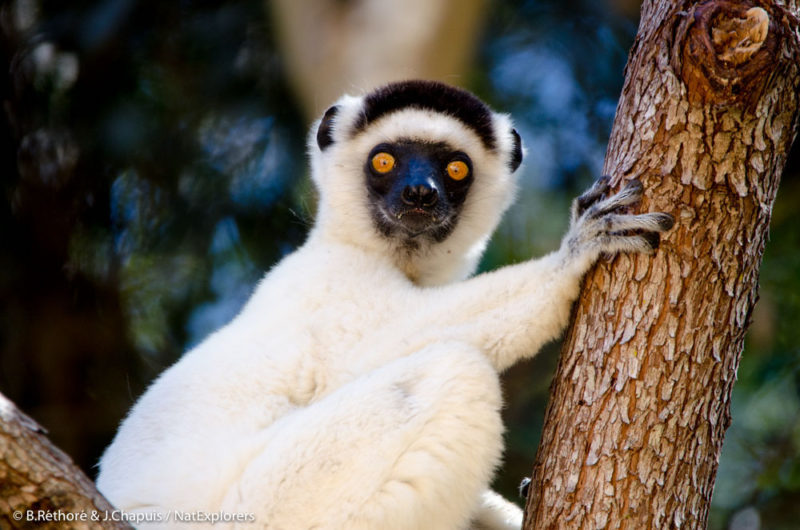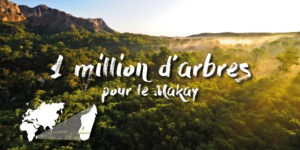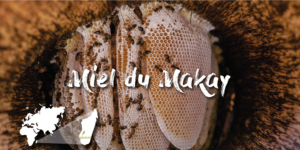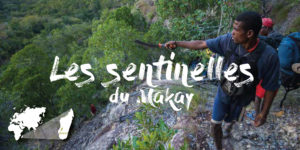ENDANGERED – The update of the IUCN Red List of Threatened Species in 2020 has once again put the spotlight on lemurs, these primates that only exist in Madagascar. Little known to the general public until the cartoon ‘Madagascar’, they are nevertheless the most endangered mammals in the world and the most emblematic of the Grande Île. What future for such endearing hairballs? What solutions for their survival? What if the Makay was more to the lemurs than just another territory?
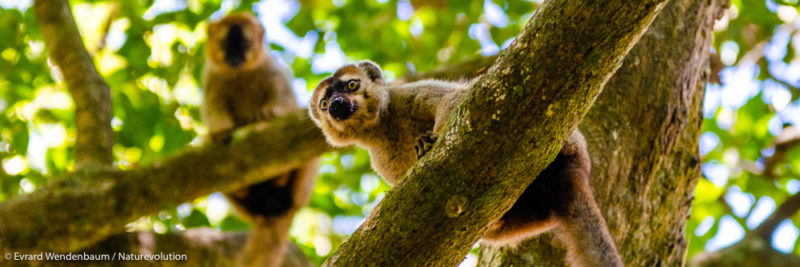
Lemurs, primates apart
The lemurs are very distant cousins of the monkeys: they diverged (along with the loris) from the rest of the primates more than 50 million years ago, well before the diversification and growth of the monkeys.
Originally present in Africa, lemurs arrived in Madagascar at a time when the island was closer to the mainland. Ocean currents have carried, for millions of years, floating vegetation rafts carrying lemurs. Without competition, the lemurs then spread all over the island of Madagascar, diversifying into more than a hundred species and occupying all the natural habitats of the island. Some even weighed 200 kg !
Lemurs remaining on the African continent had to compete with monkeys and other small mammals. When put into competition, they eventually disappeared from the continent, which explains why today they are only found in Madagascar.
A gradual decline
The first humans arrived in Madagascar about 10,000 years ago. But it was only between 700 and 1000 AD that the island’s megafauna – elephant-birds, man-sized lemurs, and giant fossas – disappeared, during a population explosion linked to the transition from a hunter-gatherer lifestyle to agriculture and animal husbandry. This agricultural transition, coupled with the influx of migrants from Indonesia, increased pressure on natural habitats even as lemurs continued to be hunted.
17 species of lemurs have since become extinct, all larger than current species. Il reste aujourd’hui 113 species or subspecies of lemurs, present on 10% of Malagasy territory.
Lemurs before humans?
Lemurs before humans had a much larger range than they do today. They were also more diverse: 20 or more species could be found at a given site, compared to 10-12 today. Even the lemurs that are not extinct today are smaller and lighter than their ancestors, as evidenced by their fossils.
These data from recent research indicate that the disappearance and scarcity of lemurs is a continuous and accelerating process, linked to the presence of humans and dating back several centuries or even several millennia, and not the result of purely contemporary phenomena. The intensity of today’s threats is only a final blow to the lemurs.
Ensuring the survival of lemurs must be the result of a conscious choice to leave space for them, as is the case for all species that require a bit of wild space to live.
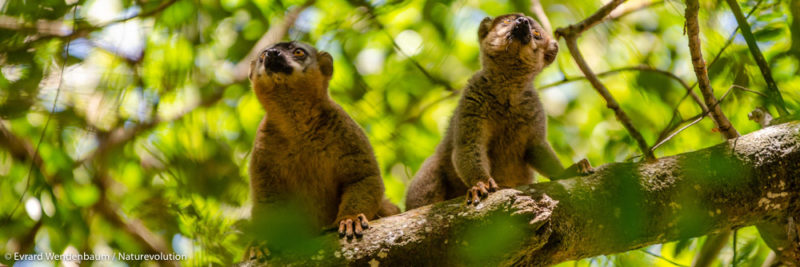
A situation now critical
Protected since 1927, conservation efforts around lemurs have managed to slow their decline somewhat, but they have never been able to stop it. The situation is now catastrophic, and scientists estimate that many species of lemurs could become extinct by 2050 if the trend is not reversed quickly.
The International Union for the Conversation of Nature (IUCN) chose, during the July 2020 update of the Red list of threatened species, to focus on lemurs. And for good reason, Almost all species of lemurs are now endangered. One third of them are classified as ‘critically endangered’, the last step before extinction into the wild. Far from improving, the situation has deteriorated in recent years.
| % of lemur species at risk of extinction | 2008 | 2012 | 2020 |
| Critically Endangered Species (CR) Extremely high risk of extinction in the wild | 6% | 23% | 31% |
| All endangered species (CR+EN+VU) High, very high, and extremely high risk of extinction in the wild | 74% | 94% | 98% |
Among the species most at risk of extinction, we note, for example, the Berthe’s Mouse Lemur, the smallest primate in the world, or the Verreaux’s Sifaka (or Propithèque), which can be found in the Makay massif.
The reasons for their disappearance
Deforestation
Deforestation, and the loss of their habitats, is the primary threat to lemurs. In question are bush fires, whether they are triggered for farming or for other reasons, the cutting of trees to produce charcoal, firewood or cooking wood, or the conversion of land for agriculture. It is estimated that between 1950 and 2000, Madagascar lost 40% of its forest cover. And deforestation has only accelerated since then.
Destruction or degradation of different habitats – dry forests, wet forests, thorny forests, etc. – is worrying: the Sifakas, for example, depend for their food on plants that exist only in certain natural environments. The disappearance of these habitats will inevitably lead to the disappearance of the Sifakas, who are unable to adapt to a radical change in their diet.
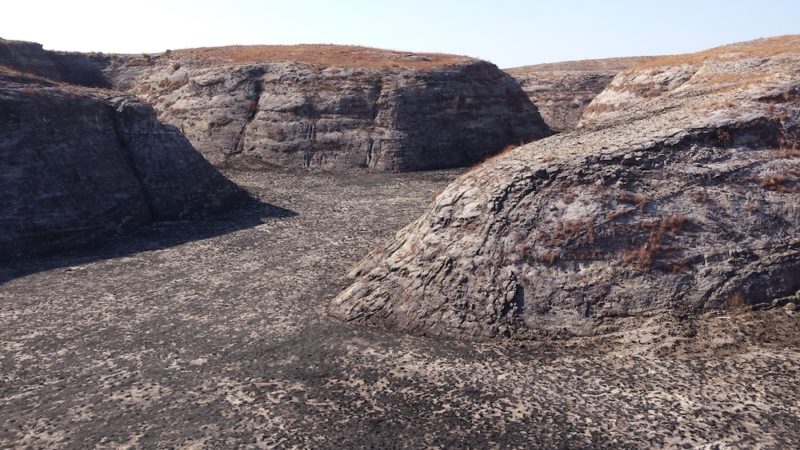
Global warming
Global warming is the second major threat to lemurs, as it changes the climate of their ranges. Madagascar is one of the countries most at risk in terms of global warming, while being one of the least contributors to its emergence. This threat therefore originates within developed countries, which are major emitters of greenhouse gases.
Its effects are subtle but fatal: the lengthening of the dry seasons leads, for example, to a scarcity of young bamboo shoots essential to the diet of the Hapalemurs, these ‘bamboo lemurs’ of which some species are present in the Makay. Forced to fall back on the woody part of the older plants, their teeth wear out faster and their food becomes poorer. What was tolerable 4 months a year may put bamboo lemurs in a state of chronic starvation if the dry seasons last 6 months. Such a seemingly minor change may prove to be a tipping point leading to the extinction of the species within a few years.
At least one third of lemur species will experience a 60% reduction in their potential habitat over the course of the 21st century, due solely to global warming. Worse still, these habitats will not only shrink in size but will also move as the climate changes, and some lemurs will have to migrate long distances (see map opposite).
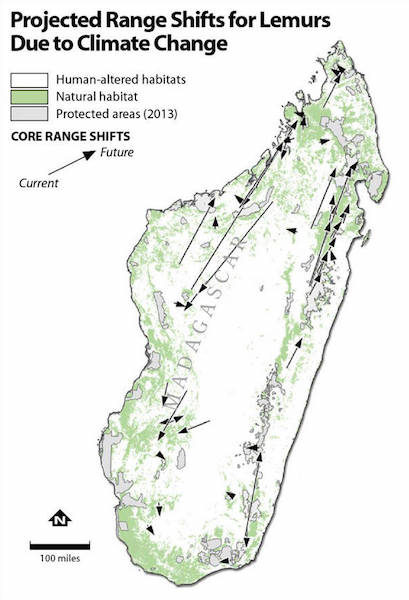
Between the destruction of natural habitats and the need to undertake a perilous ‘climate migration’, the survival of most lemur species is far from assured
The poaching
On a smaller scale than the previous two, hunting finally puts additional pressure on some species of lemurs. It is of course illegal, but it is also sometimes subject to a cultural taboo, the “fady“, especially for species considered to be physically similar to humans. The Sifaka, for example, is protected by such a taboo in many places where it is found, but sometimes it remains hunted. A distinction is made between :
- Poaching for subsistence to feed the family of the hunter himself, usually in a very precarious situation, is the majority. It is the latter that, until then exceptional in the Makay, experienced a resurgence with the Covid-19 crisis because the lemur is usually hunted only as a last resort.
- Poaching for commercial purposes for food (well-to-do amateurs in the cities looking for lemur meat), for tourism (hotels and restaurants displaying lemurs in cage), or for the trafficking of pets (in Madagascar itself) is a minority. These last two points can be exacerbated by the spread of viral videos on social networks, generating the desire to own a tamed maki catta or take a selfie with a lemur while traveling.
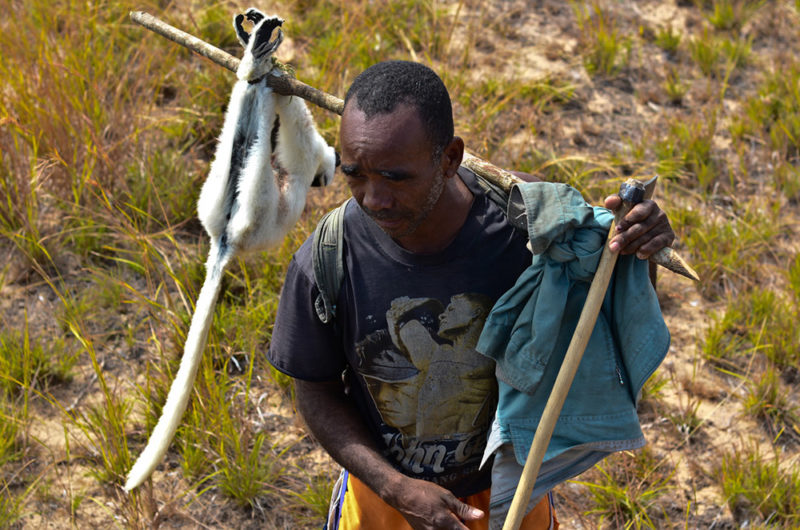
What strategy to protect lemurs?
Locally – As the loss of natural habitats to human activity is the main cause of the decline of lemurs, the creation of protected areas to preserve suitable ecosystems seems to be the best strategy to follow. Since it is also possible to project the displacement of the habitats of each lemur species, it is also possible – at least in theory – to protect future habitats and migration corridors. But does it work? That’s what we’ll see in the rest of the article.
Overall – It is worth remembering that even if the current ranges of lemurs could be fully protected overnight, global warming will progressively render the relevance of some protected areas obsolete. Each additional half-degree of warming will significantly increase the complexity of protecting lemur habitats as they move, even as the population faces increasingly challenging environmental conditions. For some species of lemurs, the movement will even be impossible because the arid plateaus in the centre of the island will be impassable for them or because they will be blocked by territories too modified by man. Combating global warming is therefore a priority for the protection of lemurs, and of all biodiversity.
Act on my level ?
We can all take action against global warming, and thus reduce our impact on biodiversity – including lemurs. Among the multitude of ‘green gestures’ whose scope can often be doubted (and which do not replace collective or professional mobilizations aimed at bringing about societal change), there is one that has a positive impact beyond any other:have a predominantly plant-based diet (vegetarian/vegan). This reduces both greenhouse gas emissions and the amount of agricultural land associated with food production. It also reduces the conversion of natural areas (deforestation) to cropland.
For more information, read our article Taking action against deforestation: actions are roughly the same as for climate and are prioritized.
Are protected areas effective ?
Can protected areas “save lemurs” ? There are few scientific studies to establish a roadmap for the success of a protected area, but there are a number of proven results to estimate the way forward.
An analysis of 56 scientific studies conducted by Mongabay indicates that overall protected areas have a positive impact on forest cover and succeed in reducing deforestation, if funded. Protected areas ‘on paper’, i. e. without funding and therefore without conservation actions, have little impact.
But a forest can have intact forest cover while still being completely devoid of animal life, be it large predators, small mammals, reptiles or even birds: this is the “empty forest syndrome”, a term used to describe this phenomenon in South-East Asia where poaching reaches catastrophic proportions. Although data are available for some species, the ‘whole’ health status of a natural environment is much more difficult to assess than changes in forest cover, which can now be easily measured by satellite. Indeed, there are no scientific studies to show that protected areas are effective in reducing poaching, largely because of the lack of data and the methodological difficulty of conducting such a study.
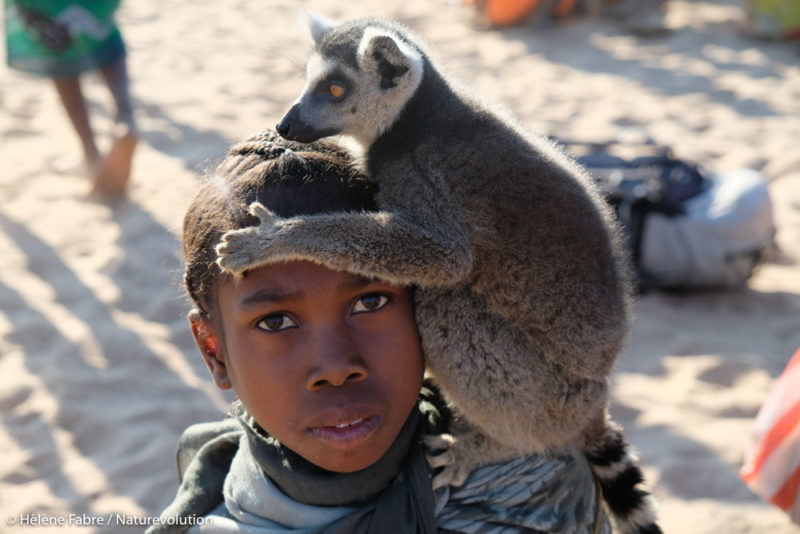
Overall, Protected areas support greater diversity and abundance of animal species the surrounding areas, either because nature conservation has been successful or because the protected area was originally created on a particularly rich area (this is the case for the biodiversity of the Makay), and probably due to a combination of these two reasons.
Similarly, another analysis shows that animal and plant species in at least half of protected areas are declining, including predators, large mammals and the tallest trees, demonstrating that protected areas today are only partially responding to human pressures on wildlife and natural resources. As we saw during the Covid-19 pandemic, it does not take much for the pressure on natural environments to increase rapidly, especially since it is precisely these environments that still contain relatively abundant natural resources to be exploited.
On the other hand, for all the reasons mentioned in the box below, there is currently no scientific way to know whether the situation would have been better (or worse) in the absence of protected areas.
Why is it difficult to measure the effectiveness of protected areas ?
The difficulty of measuring causal relationships in the management of protected areas and of drawing a general answer on their effectiveness is related to many factors.
- First of all, there are many different protection statuses for nature areas, including within the same country (regional nature park, national park, integral reserve, community forest, etc. with a wide range of permitted uses and prohibitions).
- Most protected areas lack baseline data (pre-status status of the natural environment), particularly because attention to the environmental status of the protected area only begins when a proposal for a protected area is submitted and considered a priority.
- Moreover, protected areas are often created around areas that are either exceptional in terms of biodiversity or protected due to lack of better economic use. Thus, it is often impossible to have an equivalent ‘control’ area to observe what would have happened in the absence of protection and to make a comparison.
- It should also be noted that there are very few studies on the management of protected areas, a phenomenon mainly due to the fact that there is already very little money allocated to nature protection and that protected areas are chronically underfunded.
- Finally, when studies are carried out, the evaluation criteria used often differ from one study to another (forest cover, population trends of particular emblematic species, etc. ).
So what the studies show is that protected areas today are in the right place: they are home to the most biodiverse habitats, and they are a bulwark against deforestation and loss of natural habitats. Unfortunately, they are only partially reversing the rapid decline in biodiversity across the planet, and they are sorely underfunded (by way of reference, only 3% of global philanthropy is dedicated to environmental causes).
In view of these mixed conclusions, we at Naturevolution see protected areas as bastions of biodiversity perilously situated on the brink of a global crisis. And for good reason: many protected areas contain the mineral resources needed for renewable energy, and arbitration in such a conflict of use is rarely in favour of nature. On the other hand, some of the most precarious populations on the planet live in or on the edge of protected areas: if it places conservation projects in a difficult economic context, it is up to us as conservation actors to ensure that protection of nature goes hand in hand with improved living conditions.
The Makay and the lemurs
A vast massif rich in lemurs
Out of 113 species and subspecies of lemurs in Madagascar, the Makay is home to 10 confirmed species, and potentially 11 in total. This makes Makay a massif with one of the most diverse species of lemurs in Madagascar.
With 4000 km2, the Makay is also one of the largest protected areas in Madagascar, and its difficulty of access means that, in many canyons of the massif, the lemurs are essentially quiet most of the time. Around the Makay River, although the population pressure is present, the population density remains relatively low compared to the rest of Madagascar.
What lemurs are found in the Makay ?
4 species of diurnal lemurs and seven species of small nocturnal lemurs are found in the Makay. Among the diurnal lemurs, the Verreaux’s sifaka, with its white coat and black face, is clearly the star of the massif. Present throughout the southwest of Madagascar, it is frequently seen in the Makay. Despite this, it has just been classified as Critically Endangered (CR) and has joined the ranks of lemurs pushed to the edge of the Anthropocene precipice.
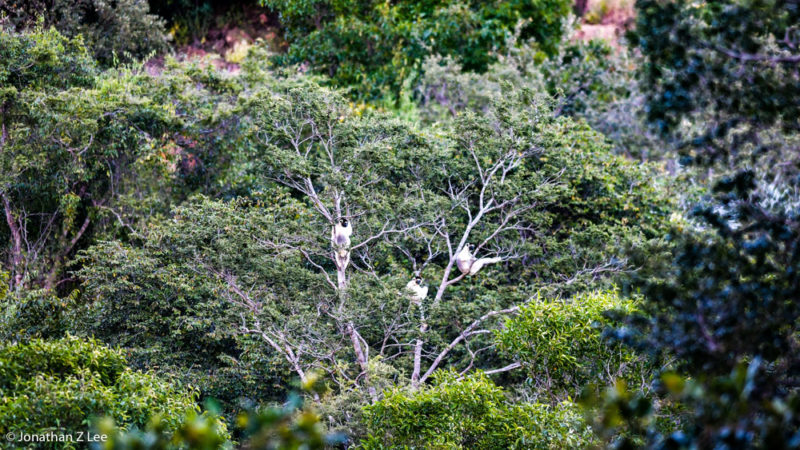
Much more common elsewhere in Madagascar is the red-fronted lemur (Eulemur rufifrons), which we see almost every mission, classified as vulnerable (VU). Also among the diurnal lemurs is the small bamboo hapalemur (Hapalemur griseus ranomafanensis) also classified as vulnerable (VU) and that we have only seen twice in the Makay. Finally, the famous maki catta (Lemur catta), classified Endangered (EN), would be present in the south of the massif according to the villagers but we have not yet observed it ourselves.
Nocturnal lemurs are much more numerous and much harder to observe. In the Makay there are:
- 3 endangered species (EN) : the Bongolava microcebe (Microcebus bongolavensis), the Coquerel microcebe (Microcebus coquereli), the western forked lemurian (Phaner pallescens).
- 2 species vulnerable (VU): the middle chirogal (Cheirogaleus medius), the red-tailed lepilemur (Lepilemur aff. ruficaudatus)
- 2 species Minor Concern (LC): the reddish-gray mouse lemur (Microcebus griseorufus) and the gray mouse lemur (Microcebus murinus).
The Makay, a refuge of last chance ?
The Makay is vast and, as such, represents a constellation of habitats for lemurs that have inhabited it for centuries. But beyond its size, some features make the Makay a particularly lifesaving place for lemurs in a warming world where population pressure is accelerating.
- Micro-climatic gradients: the particular topography of the Makay means that hot and arid environments are very close to wet and cooler environments, sometimes just a few hundred metres apart vertically, which lemurs can quickly cross. They should logically be less constrained geographically and a priori have more possibilities for local adaptation than, for example, in a lowland forest where the ecosystem and climate are more homogeneous over longer distances.
- A huge North-South corridor: warming disturbs ecosystems and, in particular, makes them evolve along North-South axes. For example, it is estimated that plant species ‘migrate’ to higher latitudes by about 300 m per year due to warming. The north-south orientation of the Makay thus provides a 150 km long corridor allowing species to change latitudes over a considerable distance.
- An impassable terrain: although locals and tourists are increasingly visiting the interior of the Makay, this remains extremely relative. Makay is not conducive to the establishment of villages, as it is not possible to grow enough food or keep herds there for long periods of time. As for tourism, being very far from the capital and major roads, it remains “niche”, focused on hiking and adventure. This is not to say that a family settled in a forest, villagers coming regularly to hunt, or a group of passing tourists cannot cause significant damage, but – relatively speaking – the Makay remains immune from major changes that may quickly affect less rugged natural environments.
The Makay represents – perhaps more than anywhere else – a range of future optimists for some of Madagascar’s lemurs, at what is undoubtedly the most critical moment in their history. But that does not mean that everything is won. Faced with the threats to the Makay River, we have put in place a series of projects that offer concrete solutions. Join us !
10% of Madagascar’s lemur species can find in the Makay a sanctuary that may be their last chance to survive – if we manage to protect it !

